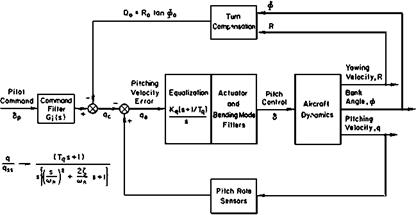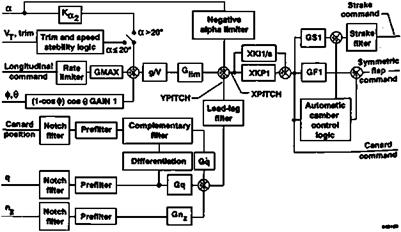Superaugmentation, or Augmentation for Unstable Airplanes
The design goal of classical stability augmentation, such as in the XB-47 and YB-49, is to merely restore acceptable flying qualities such as well-damped Dutch roll or pitching oscillations to airplanes that have poor characteristics. The loss is usually due to operation at high altitudes, or at low speeds with airplanes designed for high speeds.
With the success of classical stability augmentation designers have become bold. They now offer the prospect of significant flight performance gains by flying unstable airframes. Superaugmentation makes inherently unstable airplanes have stable flight characteristics while retaining the performance gains. The greatest performance gains appear possible for
airplanes inherently unstable in pitch. According to Peter Mangold, maximum lift coefficient increases of 25 percent and trim drag decreases of 20 percent can be obtained with a longitudinally unstable tailless design as compared with its stable counterpart. These large improvements arise from the down-trailing-edge angles required to trim an unstable flying wing, increasing wing camber. A negative camber is required to trim a stable flying wing. More modest gains are available for tailed airplanes, where down-trimming tail loads operate on longer moment arms to the airplane’s center of gravity.
According to Duane McRuer, the designers of the YB-49 gave a great deal of thought to flying that airplane with unstable loadings, to take advantage of the performance gains. However, Waldemar O. Breuhaus claims that the first actual application of superaugmentation was made on a North American AT-6 trainer. A Sperry airline-type A-12 automatic pilot flew the AT-6 quite successfully with a negative static margin of 6.7 percent of the wing chord. In current practice, the General Dynamics F-16 was designed to fly with a slight negative static margin. Depending on store loadings, this is the case in practice. To reduce horizontal tailtrim loads during cruise, fuel is pumped into cells in the horizontal tails of the McDonnell Douglas MD-11 and the Boeing 747-400.
There are two general paths to superaugmentation. The most obvious is to artificially increase back to stable levels those derivatives that characterize longitudinally unstable airplanes. These are the derivatives Ma, Mq, and Mu. Feedbacks to the longitudinal control of angle of attack, pitching velocity, and airspeed, respectively, are required. However, there are practical problems with feeding back angle of attack and airspeed signals at high gain. Vertical and horizontal air turbulence components appear as objectionable noise inputs. Atmospheric turbulence noise effects may be partially compensated with complementary filters, which replace the higher frequency atmospheric turbulence signals with their inertially derived equivalents, inertial vertical and horizontal velocity. The airframe thus acts as a filter on the high-frequency turbulence signals.
The alternate path to superaugmentation relies on inertially based signals, such as pitching velocity, derived pitch attitude, and normal acceleration. Inertial signals lend themselves to modern redundant mechanizations. For example, five or six rate gyros in a skewed orientation can provide fail-operational capability for all three airplane axes. Figure 20.5 illustrates
|
Figure 20.5 Example of a block diagram for an inertially based superaugmentation system for longitudinally unstable airplanes. The denominator s in the Equalization box integrates the pitching velocity error signal qe, providing a pseudopitch attitude signal. (From Myers, McRuer, and Johnston, NASA CR 170419, 1984) |
|
Figure 20.6 Block diagram for the X-29A research airplane superaugmented pitch control system, designed to overcome unstable static margins of up to 35 percent of the wing mean chord. Pitch angular acceleration is synthesized with filtered canard position. Normal acceleration feedback provides proper stick force per g. (From Clarke, Burken, Bosworth, and Bauer, NASA TM 4598, 1994) |
superaugmentation by pitch rate feedback, integrated for a derived pitch attitude (McRuer, Johnston, and Myers, 1985). An aperiodic divergence caused by static longitudinal instability is eliminated as system gain is increased. A new longitudinal short-period mode appears with relatively high damping and frequency, making possible precision attitude control, provided that proper attention is paid to flight path response (Gibson, 1995). Large stability margins are attained. This provides robustness against parameter changes. The X-29A pitch control system, illustrated in Figure 20.6, is another inertially based superaugmented case.
Control system rate or position saturation can be particularly deadly for superaugmented airplanes. Once the control surfaces are operating at actuator-limited rates or against the surface stops the design reverts back toward the unaugmented, or unstable, case. In design studies, one must identify the command or disturbance levels that could cause unacceptable divergences due to control rate and position saturation.













